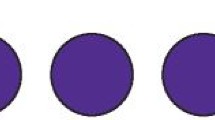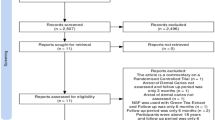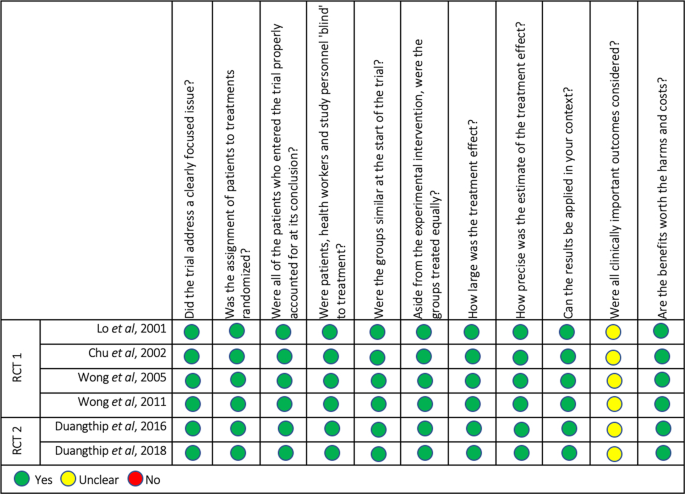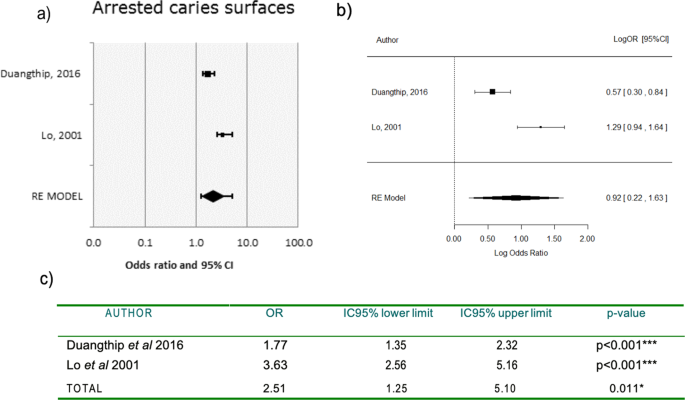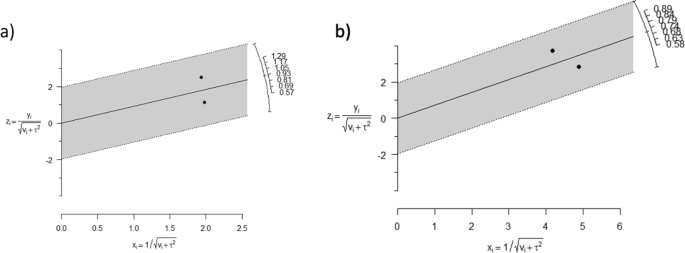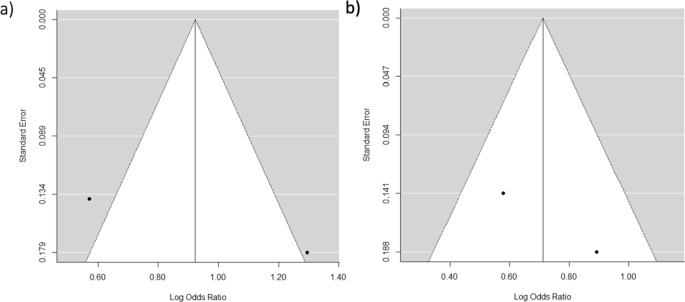Abstract
Dental caries can compromise quality of life and is associated with demineralization of tooth structure by organic acids produced by microorganisms. This study systematically reviewed the dentine caries arrest capabilities of silver diamine fluoride (SDF) and sodium fluoride (NaF). A comprehensive search strategy was developed to identify the relevant publications in electronic databases and hand searched journals and reviews (to March 2018). By applying strict inclusion and exclusion criteria, only six papers (two randomized controlled trials, two follow-up articles and two secondary statistical analysis studies) were considered for full text qualitative and quantitative assessment. The included studies were critically appraised and statistically evaluated. Only four articles were considered for meta-analysis, as the other two were secondary analyses of included studies. When comparing the caries arrest lesions of SDF and NaF, SDF was found to be statistically more effective in dentine caries arrest of primary teeth during the 18 and 30 month clinical examinations. The weighted total effect size of the differences between SDF and NaF regarding arrested caries surfaces was calculated and showed nearly double the effectiveness of SDF to NaF at 30 months. Therefore, SDF is a more effective caries management reagent than NaF. Further clinical research is needed to consolidate the findings of this systematic review.
Similar content being viewed by others
Introduction
Dental caries is associated with demineralization of tooth structure by organic acids produced by microorganisms, which can progress from the outer tooth structure towards the inner vital tissue causing pain and swelling1. In the United States, dental caries is the single most common chronic childhood disease, with more than half of children experiencing one or more decayed or filled surfaces by the age of five and this prevalence increases to more than 78% amongst 17 year olds2. Untreated caries can result in life threatening conditions requiring hospitalization1. For instance, toddlers with untreated caries exhibit poor quality of life involving pain, eating and drinking difficulties, sleeping difficulty and a sense of guilt amongst the family3, while pre-school aged children also experience disturbed sleep, stunted growth, higher risk of hospitalizations and emergency dental visits and increased absence from school and reduced learning ability4. Therefore comprehensive evidence based approaches must be developed and implemented for management of dental caries.
Currently, management of dental caries involves preventive and non-preventive treatment methods. While non-preventive caries management involves stopping or slowing the disease progress by mechanical caries removal and restoration of decayed tooth structure, preventive caries protocols, on the other hand, are implemented to prevent the onset of caries and protect the teeth from the conditions that favor the harmful impacts of oral biofilm. These protocols include: nutritional counseling, fluoride use, oral hygiene instructions, topical antimicrobial agents and the use of sugar alcohol sweeteners such as xylitol5. In addressing carious lesions, prevention by routine dental visits, oral hygiene and nutritional counseling resulted in a reduced number of non-preventive dental visits6.
Topical fluorides, such as NaF varnish, are used as preventive reagents because of their remineralization and antimicrobial abilities7. In 2014, the FDA approved SDF use for tooth sensitivity, with an off-label use in caries treatment and prevention and additionally approved the marketing of SDF with potassium iodide (Riva Star, SDI Limited) in 2018. SDF (38% Ag (NH3)2F) is a colourless liquid composed of 24–29% silver and 5–6% fluoride. It is also an alkaline reagent with pH 109, which provides an unfavorable environment for dentine collagen enzyme activation8. Also, silver has been used as a medical antimicrobial since the 17th century9 and in dentistry during 191710.
Mei et al.11 demonstrated the ability of 38% SDF to inhibit demineralization and promote preservation of collagen of demineralized dentine by forming a protective layer on and within the dentinal tubules in vitro11. The latter findings suggest that SDF could be an effective preventive protocol and potentially a replacement of the commonly used NaF. This however requires a systematic and comprehensive assessment of evidence into the clinical efficacy of each reagent in managing dentine caries.
Therefore, the aim of this study was to systematically review the dentine caries arrest capabilities of SDF and NaF.
Results
Study Selection
A literature search was performed through electronic databases: Ovid, PubMed, Web of Science, and Cochrane Library and yielded 67 articles. In addition, hand searching through relevant journals and reviews resulted in 40 additional articles. The titles of the identified studies were reviewed, and 26 duplicates were excluded. Then, the abstracts and full text of the remaining 81 abstracts were independently reviewed by two investigators (Trieu and Mohamed) to determine whether an individual study was eligible for full text qualitative and quantitative analyses in this systematic review. The inclusion criteria were as follows: (1) cohort or case-control or controlled or randomized control study designs (2) included the previously mentioned key words (3) only articles published in English and (4) studies performed in humans. The exclusion criteria were as follows: (1) non-English articles (2) in vitro studies (3) narrative reviews and (4) expert opinions (5) enamel caries (6) adults greater than 12 years old. For detailed information on inclusion and exclusion criteria, please refer to Table 1. Disagreements among the two investigators were resolved by a third independent reviewer (Lynch). As a result, 75 articles were excluded as per the exclusion criteria and the remaining six articles were then subjected to full-text qualitative and quantitative analyses. Please refer to Fig. 1 for detailed information on study selection process.
Study characteristics
Through the literature search, six articles met inclusion criteria. They were published between 2001 and 2018 and included four randomized controlled trials (RCT)12,13,14,15 and two studies which were secondary statistical analyses of RCTs16,17. However, the four identified RCTs consist of two individual studies (Lo et al.14 and Duangthip et al.13), while the remaining two RCTs were their follow-up articles reporting results at later time points (Chu et al.15 and Duangthip et al.12).
The included studies recruited a total of 746 pre-school children with a mean age of 3.4 years12,13 and 4.0 years14,15. The RCT by Duangthip et al.13 and its follow-up article (Duangthip et al.12) reported sample size calculations12,13, while the other RCT and its follow-up article did not14,15. Dropout rates were recorded in all articles.
Of the studies, the RCT by Lo et al.14 and its follow-up article focused on carious lesions of upper anterior primary teeth only14,15, while the other RCT by Duangthip et al.13 and its follow-up article included both anterior and posterior primary teeth12,13. Lo et al.14 and its follow-up article used 38% SDF14,15, while Duangthip et al.13 and its follow-up article used 30% SDF, but all RCTs compared the SDF intervention to 5% NaF varnish. All RCTs utilized the decayed, missing, and filled surfaces (DMFS) protocol to record outcomes by tactile examination. Lesions were classified as active caries or arrested caries using sharp sickled probes14,15 or ball ended probes12,13. Oral hygiene (OH) at home was evaluated by parental questionnaire in all RCTs, and clinically examined and recorded by using a visible plaque index (VPI) in one RCT and its follow-up article12,13. In addition to DMFS, demographic background (gender, age) and oral health related behaviours (frequency of tooth brushing, use of fluoride toothpaste, snacking habits, location of treated caries lesion, presence of plaque on lesion) were included in the statistical analysis12,13. Inter-examiner variability was measured and kappa statistics were completed in all RCTs for examiner discrepancies.
Study findings and outcomes
In Duangthip et al.13, three treatment groups were established to compare dentine caries arrest between SDF and NaF by employing varying application intervals (annual and 3 weekly applications) and examination time points at 6 months (m), 12 m, 18 m. Caries arrest rate was significantly higher in the SDF groups (annual and 3 weekly applications) compared to NaF (3 weekly applications) (p < 0.001, CI 95%). Duangthip et al.12 extended the latter study by adding examination time points at 24 m and 30 m. At 30 m, Duangthip et al.12 reported the caries arrest rate of Group 1 (annual SDF application) to be significantly higher than both Group 2 (3 weekly SDF application) and Group 3 (3 weekly NaF application) (p < 0.001).
Lo et al.14 found a statistically significant difference in caries arrest rate by SDF over that of NaF or water (p < 0.001). Chu et al.15 furthered the study to 30 m and found SDF groups arrested caries better than all other groups (p < 0.001) and with more arrested lesions appearing black than other groups (p < 0.001), but parental satisfaction with their child’s dental appearance and dental health did not significantly change (p < 0.05). Chu et al.15 found that soft caries removal.
Prior to SDF application did not induce a significant difference in the caries arrest rate when compared to SDF application without excavation (C.I. 95%).
Wong et al.17 and Wong et al.16 conducted secondary statistical analyses (Bayesian and multivariant model, respectively) on previously collected data in RCTs by Chu et al.15 and Lo et al.14. Wong et al.16 found that SDF resulted in a shorter arrest time than NaF. Wong et al.17 applied the Bayesian model and found that soft caries excavation resulted in a shorter caries arrest time than no excavation, and that SDF induced caries arrest time was reduced compared to NaF.
The details of all the included studies are shown in Table 2.
Quality assessment
All RCTs developed PICO formulated question(s) involving caries arrest by the use of SDF intervention compared to NaF. Sample size calculations were performed in Duangthip et al.13 (and also reported in the follow-up article Duangthip et al.12), but were not performed in Lo et al.14 or any of its follow-up articles. Patients were allocated into groups by stratified block randomization in Duangthip et al.13 and Duangthip et al.12, while Chu et al.15 and Lo et al.14 utilized sequential allocation. All RCTs utilised blinding protocols. While the study by Duangthip et al.13 and its follow- up article (Duangthip et al.12) adopted a triple blind protocol where the treatment providers, sole examiner and participants were blind to the intervention/control, the study by Lo et al.14 and its follow-up article (Chu et al.15) employed a double blind protocol where an independent examiner was recruited in the study. However, due to the difference in physical appearance between intervention and comparison reagents, patients, providers and/or examiners were likely able to distinguish between the intervention and comparison reagents. Otherwise, all groups were treated equally during the treatment time including the number of exams and/or treatment visits each group attended.
Clinically important outcomes were recorded and statistical analyses were conducted. Dropouts were reported in all articles. Lo et al.14 and its follow-up article (Chu et al.15) reported no statistically significant differences in the number of non-vital teeth among the five treatment groups, while Duangthip et al.13 and its follow-up article (Duangthip et al.12) reported drop out by true failure to follow up or had moved, number of teeth needing restorative treatment, and exfoliation. Duangthip et al.12 found no significant difference between all groups regarding prevalence of non-vital teeth in the International Caries Detection and Assessment System (ICDAS) 3–4 (p > 0.05). Benefits, harms, and costs regarding treatment agents were discussed in all RCTs. The overall inter-examiner variability was 92.4% for the six included studies. High concordance was observed, signifying high reproducibility between the two examiners. The details of all the included studies are shown in Fig. 2.
Quality assessment of the included studies by CASP tool. Summary review of the qualitative assessment of the included studies by using CASP tools for randomised controlled trials (RCTs) consisting of 11 quality criteria. Green-coded circle indicates that the study satisfactorily met the respective quality criterion, yellow-coded circle indicates that the study partially met the respective quality criterion, and the red-coded circle indicates that the study did not meet the respective quality criterion.
Statistical meta-analysis
Two meta-analyses were conducted, encompassing: Lo et al.14, Chu et al.15, Duangthip et al.13 and Duangthip et al.12. In meta-analysis 1, arrested caries by treatment group were analyzed in the 18 m trials of Lo14 and Duangthip et al.13, while meta-analysis 2 compared the 30 m results12,15.
Data between studies was harmonized to determine the odd ratio (OR). Individual estimated ORs and the pooled ORs were generated and revealed a significant increased probability of SDF arresting caries as compared to NaF at both 18 m (OR = 2.51, 95% CI:1.2,5.10, p = 0.011) and 30 m (OR = 2.03, 95% CI: 1.5,2.77, p < 0.001). Please see Figs 3 and 4.
Forest and logarithmic plots for pooled ORs of arrested carious surfaces (meta-analysis 1, 18 m). Forest plot for pooled ORs of arrested caries surfaces at 18 m. (a) Duangthip et al.13 reported OR = 1.77, interpreting that SDF increased the probability of arresting active caries on surfaces at 77% compared to NaF, which is higher (p < 0.001). Lo et al.14 reported OR = 3.63 >1, favoring SDF (p < 0.001). Taken into consideration that OR = 1 is the reference level whereby no effect is assigned to the test treatment SDF. OR >1 means an increment of arrested caries rate in the SDF group compared to control NaF. OR < 1 means a reduction of arrested caries rate in the SDF group compared to control NaF. Logarithmic measure for pooled ORs of arrested caries surfaces at 18 m. (b) Taking into consideration logarithmic focus provides symmetrical confidence intervals. Log(OR) = 0 is the reference level: no effect is assigned to the SDF treatment. Log (OR) >0 means an increment of arrested caries rate in the SDF group compared to control NaF. Log (OR) <0 means a reduction of arrested caries rate in the SDF group compared to control NaF.
Forest and logarithmic plots for pooled ORs of arrested carious surfaces (meta-analysis 2, 30 m). Forest plot for pooled ORs of arrested caries surfaces at 30 m. (a) Duangthip et al.13 reported OR = 1.79, interpreting that SDF increased the probability of arresting active caries on surfaces at 79% compared to NaF, which is higher (p < 0.001). Chu et al.15 reported OR = 2.44 > 1, favoring SDF (p < 0.001). Taken into consideration that OR = 1 is the reference level whereby no effect is assigned to the test treatment SDF. OR >1 means an increment of arrested caries rate in the SDF group compared to control NaF. OR <1 means a reduction of arrested caries rate in the SDF group compared to control NaF. Logarithmic measure for pooled ORs of arrested caries surfaces 30 m. Taken into consideration logarithmic focus provides symmetrical confidence intervals. Log(OR) = 0 is the reference level: no effect is assigned to the SDF treatment. Log (OR) >0 means an increment of arrested caries rate in the SDF group compared to control NaF. Log (OR) <0 means a reduction of arrested caries rate in the SDF group compared to control NaF.
Heterogeneity analysis
Heterogeneity was evaluated with Cochran’s Q Test and the I2 Index. A higher level of heterogeneity was found at 18 m (I2 = 90.3, Q = 10.29, p = 0.001) than at 30 m (I2 = 44.3%, Q = 1.79; p = 0.180). Galbraith graphs (See Fig. 5) were also generated to establish heterogeneity of the meta-analyses. Both meta-analysis 1 and meta-analysis 2 fell within confidence levels suggesting distance but lay within the confidence intervals.
Galbraith graphs for analysis of heterogeneity. Galbraith graphs for heterogeneity analysis at (a) 18 m (I2 = 90.3, Q = 10.29, p = 0.001), both studies are distanced but between the confidence levels and (b) 30 m (I2 = 44.3%, Q = 1.79; p = 0.180), both studies are distanced but between the confidence levels. Taken into consideration the horizontal axis corresponds to precision of the study and the vertical axis to standardized effect. The arch shows ln(OR) and the central line is the global effect measure.
Potential publication bias
Publication bias was evaluated with funnel graphs (See Fig. 6). Duangthip et al.13 and Duangthip et al.12 reported a larger sample size and thus increased precision, but both meta-analysis 1 and meta-analysis 2 showed acceptable symmetry. No publication bias was detected.
Funnel plots for publication bias. Funnel plots for publication bias at (a)18 m Duangthip et al.13 is vertically higher, exhibiting a higher precision, due to its larger sample size with acceptable symmetry for this precision level and (b) 30 m Duangthip et al.12 is vertically higher, exhibiting a higher precision due to larger sample size. Taken into consideration that an acceptable symmetry at this precision level, there are some articles reporting different effects regarding effectiveness of SDF to NaF.
Discussion
Dental caries is one of the most common chronic childhood diseases2. It is therefore essential to identify approaches for the management of dental caries that are minimally invasive and less traumatic, such as water fluoridation, fluoridated toothpastes, topical fluoride varnishes18. Fluoride interferes with microbial processes of the oral biofilm and inhibits demineralization19. Thus fluoride is not only a preventive mean to reduce caries prevalence, but can also partake in caries arrest. The results of this meta-analyses found that SDF, when compared to NaF, was a more effective fluoride containing reagent for dentine caries arrest in children.
After reviewing the published literature, six articles met inclusion criteria for this systematic review. However, only four articles were considered for meta-analyses comprising two individual RCTs, both of which reported results at 18 m13,14 and at 30 m12,15 time points. Articles excluded from the meta-analysis were due to 1) different reported effect measures and 2) different group comparisons. Duangthip et al.13 provided hazard ratios, whereas Wong et al.17 estimated relative risk, both studies could not be analyzed due to the limited number of studies and lack of raw data. Also, Duangthip et al.13 directly compared SDF to NaF, whereas Wong et al. 2011 compared intervention groups (SDF or NaF) to controls and estimated the time-varying regression coefficients that Duangthip et al.13 did not mention.
The quality of each study was critically appraised using CASP protocols for RCTs. Sample size calculations were not reported by Lo et al.14 and its follow-up article (Chu et al.15) so the quality of their papers is therefore compromised as the sample may not have been a true representation of the population. In general, the articles met most CASP criteria with the aforementioned exceptions, meaning their level of evidence was high and thus supporting their outcomes.
The findings of this systematic review need to be viewed with caution as the study encountered limiting factors. For instance, all RCTs were conducted in Guangzhou, China and Hong Kong, China, which represent a very specific demographic with a diet, hygiene regimen, and water fluoridation different from the western culture. All RCTs reported blind randomization. While the study by Duangthip et al.13 and its follow-up article (Duangthip et al.12) adopted a triple blind protocol where the treatment providers, sole examiner and participants were blind to the intervention/control, the study by Lo et al.14 and its follow-up article (Chu et al.15) employed a double blind protocol where an independent examiner was recruited in the study. However, SDF and NaF differ in both colour and texture and could have been discerned by examiner and treatment provider, therefore compromising their12,13,14,15 ability to treat all group equally. This could play a role in reporting the outcomes of the studies12,13,14,15,16,17. Within the meta-analyses, only those in English were included, which could limit potential foreign publications. Although six articles were identified, all included studies are based on two clinical trials. It would be ideal to conduct further clinical trials to formulate stronger clinical recommendations.
In summary, SDF is more effective as a dentine caries arresting reagent than NaF and has many implications for pediatric dentistry. There is a reduced treatment cost associated with SDF/Fluoride varnish use20. The ease of application can result in greater delivery of the reagent to a larger population of children with untreated caries. The main reported disadvantage being the non-aesthetic black colouring of carious lesions after SDF application12,13,14,15, however the additional use of potassium iodide has been reported to reduce the discolouration21. Surveys report a higher parental acceptance of SDF associated black staining on posterior teeth than anterior teeth, additional factors such as behavioral barriers, socioeconomic status, and indications for sedation and/or hospital dentistry also increased parental acceptance22. Though the quality of evidence and meta-analyses are strong, the findings were only based on 2 studies. Further studies are needed to evaluate the minimal necessary concentration and frequency of application to arrest dentine caries of primary and permanent teeth.
Conclusion
In view of the findings in this systematic review, SDF is a more effective dentine caries arresting agent than NaF. However, these findings need to be viewed with caution as further clinical research is needed to consolidate findings.
Methods
The Preferred Reporting Items for Systematic reviews and Meta-Analysis (PRISMA) guidelines were adopted for the current study.
Search strategy and eligibility criteria
Studies that investigated the caries arrest potential of SDF and NaF were identified by using a search strategy in the following electronic databases: PubMed, Web of Science, Ovid, and Cochrane Library to March 31st, 2018. Search terms were listed as follows: “silver diamine fluoride” or “silver fluoride” or “SDF” or “diamine fluoride” and “fluoride varnish” or “sodium fluoride” or “sodium varnish” and “dental caries” or “dentin caries” or “dentine caries” or “dental cavity” or “carious lesion” or “caries” and “caries arrest” or “dental caries activity test” or “DMF” or “decayed missing filled” and “child” or “children” or “pediatric”. The reference lists from the retrieved articles were reviewed, and hand-searched the following journals: Caries Research, Journal of Dentistry, Journal of Dental Research, Journal of Oral Health and Preventive Dentistry, and Pediatric Dentistry (to March 31st 2018) for further relevant studies.
The search strategy yielded 107 articles by using electronic and hand searching. However, only six articles were then subjected to full-text qualitative and quantitative analyses as described in the results section. Please refer to Fig. 1 for the selection process and Table 1 for inclusion and exclusion criteria.
Data extraction and quality assessment
A preset data sheet was developed to extract information from the included studies. From each included study, the following data were extracted: article, population, intervention, comparison, outcome, drop out, type of study, duration, location, statistical analysis, results and findings. Please refer to Table 2. All data was extracted by two reviewers (Trieu and Mohamed). However, disagreements between the two investigators were resolved by a third independent reviewer (Lynch). The quality of the included studies was critically appraised by the CASP for randomized clinical trials (RCT). This protocol consists of a set of eleven questions addressing key aspects of the quality of RCTs, including: question formulation, type of study, relevancy, quality, results, precision of results, application of results to populations, outcomes, and the evaluation between benefits over harms and costs of studies. For detailed information, please see Fig. 2. Inter- examiner variability among the 2 examiners was measured by calculating the percentage of agreement (%) among the 2 examiners in each CASP checklist criteria.
Statistical analysis
Pooled measurements were calculated (OR with 95% CI) by random effects model (REM) to assess the strength of association between SDF and NaF to arrest caries. A study of heterogeneity was performed in order to assess the variability between included studies using Cochran’s Q test and I2 Index. Consistency of results from different authors were explored with Galbraith’s graphs. The Funnel graphs have also been performed to assess potential publication bias. The software R 3.0.2 and its ‘metafor’ package was used to perform the meta-analyses. The level of significance used in the analysis has been 5% (α = 0.05).
References
Dean, J., Avery, D. & McDonald, R. McDonald and Avery Dentistry for the Child and Adolescent, https://doi.org/10.1016/C2009-0-48382-X (2011).
Satcher, D. Oral Health in America: A Report of the Surgeon General. Public Health 28 (2000).
Fernandes, I. B. et al. Severity of Dental Caries and Quality of Life for Toddlers and Their Families. Pediatr. Dent. 39, 118–123 (2017).
Sheiham, A. Dental caries affects body weight, growth and quality of life in pre-school children. Br. Dent. J. 201, 625–626 (2006).
Council, O. Caries-risk Assessment and Management for Infants, Children, and Adolescents. Pediatr. Dent. 39, 197–204 (2017).
Sen, B. et al. Effectiveness of Preventive Dental Visits in Reducing Nonpreventive Dental Visits and Expenditures. Pediatrics 131, 1107–1113 (2013).
Koo, H. Strategies to Enhance the Biological Effects of Fluoride on Dental Biofilms. Adv. Dent. Res. 20, 17–21 (2008).
Mei, M. L., Lo, E. C. M. & Chu, C. H. Arresting Dentine Caries with Silver Diamine Fluoride: What’s Behind It? J. Dent. Res. 97, 751–758 (2018).
Politano, A. D., Campbell, K. T., Rosenberger, L. H. & Sawyer, R. G. Use of Silver in the Prevention and Treatment of Infections: Silver Review. Surg. Infect. (Larchmt). 14, 8–20 (2013).
Gelbier, S. 125 years of developments in dentistry, 1880–2005 Part 4: Clinical dentistry. Br. Dent. J. 199, 615–619 (2005).
Mei, M. L. et al. Inhibitory effect of silver diamine fluoride on dentine demineralisation and collagen degradation. J. Dent. 41, 809–817 (2013).
Duangthip, D., Wong, M. C. M., Chu, C. H. & Lo, E. C. M. Caries arrest by topical fluorides in pre-school children: 30- month results. J. Dent. 70, 74–79 (2018).
Duangthip, D., Chu, C. H. & Lo, E. C. A randomized clinical trial on arresting dentine caries in pre-school children by topical fluorides–18 month results. J. Dent. 44, 57–63 (2016).
Lo, E. C., Chu, C. H. & Lin, H. C. A community-based caries control program for pre-school children using topical fluorides: 18-month results. J. Dent. Res. 80, 2071–2074 (2001).
Chu, C. H., Lo, E. C. & Lin, H. C. Effectiveness of silver diamine fluoride and sodium fluoride varnish in arresting dentin caries in Chinese pre-school children. J Dent Res 81, 767–770 (2002).
Wong, M. C., Lam, K. F. & Lo, E. C. Analysis of multilevel grouped survival data with time-varying regression coefficients. Stat. Med. 30, 250–259 (2011).
Wong, M. C., Lam, K. F. & Lo, E. C. Bayesian analysis of clustered interval-censored data. J. Dent. Res. 84, 817–821 (2005).
Buzalaf, M. A. R. Review of Fluoride Intake and Appropriateness of Current Guidelines. Adv. Dent. Res, https://doi.org/10.1177/0022034517750850 (2018).
Hamilton, I. R. Biochemical Effects of Fluoride on Oral Bacteria. J. Dent. Res. 69, 660–667 (1990).
Hansen, R. N., Shirtcliff, R. M., Dysert, J. & Milgrom, P. M. Costs and Resource Use Among Child Patients Receiving Silver Nitrate/Fluoride Varnish Caries Arrest. Pediatr Dent 39, 304–307 (2017).
Zhao, I. S., Mei, M. L., Burrow, M. F., Lo, E. C. & Chu, C. H. Effect of Silver Diamine Fluoride and Potassium Iodide Treatment on Secondary Caries Prevention and Tooth Discolouration in Cervical Glass Ionomer Cement Restoration. Int. J. Mol. Sci. 18 (2017).
Crystal, Y. O., Janal, M. N., Hamilton, D. S. & Niederman, R. Parental perceptions and acceptance of silver diamine fluoride staining. J. Am. Dent. Assoc. 148, 510–518.e4 (2017).
Acknowledgements
The authors thank Mr. Juan Luis Gomez Martinez for his statistical advice. This study was funded by the School of Dental Medicine, University of Nevada, Las Vegas (UNLV).
Author information
Authors and Affiliations
Contributions
A.T. and A.M. participated in study design, literature search, data collection, analysis, quality assessment, statistical analysis, interpretation, and in drafting and revising the manuscript. E.L. participated in study design, analysis, interpretation, discussion, critical revisions, and manuscript revision.
Corresponding author
Ethics declarations
Competing Interests
The authors declare no competing interests.
Additional information
Publisher’s note: Springer Nature remains neutral with regard to jurisdictional claims in published maps and institutional affiliations.
Rights and permissions
Open Access This article is licensed under a Creative Commons Attribution 4.0 International License, which permits use, sharing, adaptation, distribution and reproduction in any medium or format, as long as you give appropriate credit to the original author(s) and the source, provide a link to the Creative Commons license, and indicate if changes were made. The images or other third party material in this article are included in the article’s Creative Commons license, unless indicated otherwise in a credit line to the material. If material is not included in the article’s Creative Commons license and your intended use is not permitted by statutory regulation or exceeds the permitted use, you will need to obtain permission directly from the copyright holder. To view a copy of this license, visit http://creativecommons.org/licenses/by/4.0/.
About this article
Cite this article
Trieu, A., Mohamed, A. & Lynch, E. Silver diamine fluoride versus sodium fluoride for arresting dentine caries in children: a systematic review and meta-analysis. Sci Rep 9, 2115 (2019). https://doi.org/10.1038/s41598-019-38569-9
Received:
Accepted:
Published:
DOI: https://doi.org/10.1038/s41598-019-38569-9
This article is cited by
-
Effectiveness of silver diamine fluoride versus sodium fluoride varnish combined with mother’s motivational interviewing for arresting early childhood caries: a randomized clinical trial
BMC Oral Health (2023)
-
A multi-site service evaluation of silver diamine fluoride use for children
British Dental Journal (2023)
-
Effect of silver diamine fluoride/potassium iodide treatment on the prevention of dental erosion in primary teeth: an in vitro study
BDJ Open (2023)
-
Remineralization of early enamel lesions with a novel prepared tricalcium silicate paste
Scientific Reports (2022)
-
Kariesmanagement mit Silberdiaminfluorid - eine Literaturübersicht
Oralprophylaxe & Kinderzahnheilkunde (2022)
Comments
By submitting a comment you agree to abide by our Terms and Community Guidelines. If you find something abusive or that does not comply with our terms or guidelines please flag it as inappropriate.

